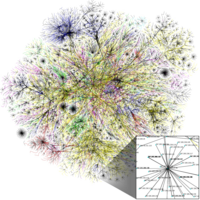
Photo from wikipedia
Patients with persistent somatoform pain disorder (PSPD) usually experience various functional impairments in pain, emotion, and cognition, which cannot be fully explained by a physiological process or a physical disorder.… Click to show full abstract
Patients with persistent somatoform pain disorder (PSPD) usually experience various functional impairments in pain, emotion, and cognition, which cannot be fully explained by a physiological process or a physical disorder. However, it is still not clear for the mechanism underlying the pathogenesis of PSPD. The present study aimed to explore the intra- and inter-network functional connectivity (FC) differences between PSPD patients and healthy controls (HCs). Functional magnetic resonance imaging (fMRI) was performed in 13 PSPD patients and 23 age- and gender-matched HCs. We used independent component analysis on resting-state fMRI data to calculate intra- and inter-network FCs, and we used the two-sample t-test to detect the FC differences between groups. Spearman correlation analysis was employed to evaluate the correlations between FCs and clinical assessments. As compared to HCs, PSPD patients showed decreased coactivations in the right superior temporal gyrus within the anterior default-mode network and the anterior cingulate cortex within the salience network, and increased coactivations in the bilateral supplementary motor areas within the sensorimotor network and both the left posterior cingulate cortex and the medial prefrontal cortex within the anterior default-mode network. In addition, we found that the PSPD patients showed decreased FNCs between sensorimotor network and audio network as well as visual network, between default-mode network and executive control network as well as audio network and between salience network and executive control network as well as right frontoparietal network, and increased FNCs between sensorimotor network and left frontoparietal network, salience network as well as cerebellum network, which were negatively correlated with the clinical assessments in PSPD patients. Our findings suggest that PSPD patients experience large-scale reorganization at the level of the functional networks, which suggests a possible mechanism underlying the pathogenesis of PSPD.
Journal Title: PLoS ONE
Year Published: 2017
Link to full text (if available)
Share on Social Media: Sign Up to like & get
recommendations!